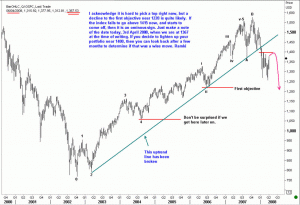Welcome to the magical world of Elliott Wave Analysis. You have probably arrived here because you wish to learn more about Elliott Wave Principle and how to use it to improve your trading performance. Whether you are trading in the foreign exchange market (forex) or in stock markets or commodities, you have come to the right spot. Some of you might have been introduced to the Wave theory earlier, but never seen it being applied in real time. Some others might regard Elliott Wave Principle as a load of B.S. because their experience with the so-called experts has been far from satisfactory. To all of you, I extend a hearty welcome. Let us make a fresh start with Wave Times, because what you see here are real-world examples taken from currency markets or stock markets or commodities markets. You will gradually learn how to read the charts more accurately, and pretty soon you will see your trading strategy improve.
I am not going to burden you with the hard-core theory, the rules and the guidelines here. You will find a lot of useful links on either side of this page that will serve as your library of links. (Feel free to return as often as you like. Remember, the more charts you study, the better you get at spotting low risk trading set-ups.) I am going to concentrate on giving you as many examples as possible from my past trading experience. Whether you are a professional trader, or a casual dabbler in any of the financial markets, an understanding of Elliott Wave Analysis will make a tremendous change to your bottom line. Happy hunting!
How do I use Elliott Wave Analysis?
I use Elliott Wave analysis to give me an idea of where we are in an unfolding move, and also how far that move could go. If there is one important lesson I have learnt in using Wave Analysis, it is this: Your analysis could be the best in the world, but until the move happens, you are no better than anyone else out there. In other words, the best use you could put your analysis is to take the trade that is suggested, but be sure to have stops in place. If it works out, then you are a hero, because you got in at the best possible levels, and managed to stick with the move for longer than most others. If you get stopped, well, you paid a smaller price than most others. Do you find this confession a bit disappointing? Unfortunately, this is the real truth.
The Wave Principle will serve you well if you accept that the market will do what it wants to do, when it wants to do it.
It is better for you to know at the outset that the financial market offers no absolutes. Take for instance, the foreign exchange market. It is one of the most liquid markets in the world. Even before the 2008 financial meltdown, in the heydays when big investment banks and hedge funds were able to place single orders running to hundreds of millions of dollars, all they could do was to temporarily move the market a few pips. So anyone who got to know that Soros was selling, and joined in slightly late, would soon find that the market came back. Quite simply, the market is too big for any one, or even a group of players to move it one way or other for too long. However, when the collective sentiment changes, there is a herd instinct that comes to play. This is precisely where Elliott Wave Principle comes to our aid.
The Wave Principle will serve you well if you accept that the market will do what it wants to do, when it wants to do it. I feel that what you really need to succeed in the markets is a guide that will help define probabilities. You should also gain, with experience, the confidence to act on your own judgement. If you can combine this confidence with the discipline that money management requires, then you are already well on the road to success, and riches.
Example of how I use Elliott Wave Analysis
Let me get you started by giving you your first example of how I used Elliott Wave Principle to anticipate a significant move in the S&P500 index. The date was 3rd April 2008, when the index had closed at 1367. I could sense that many traders were looking for the US stock markets to resume its uptrend. As usual, CNBC was giving all the ‘right’ reasons why one should continue to be optimistic. But having studied the Elliott Wave Principle for over 25 years, I felt that we should be getting ready to SELL! Take a look at the chart first, and then the accompanying notes taken from the book “Elliott Wave Principle” by A.J. Frost and Robert R. Prechter, Jr. (This is a must-read book if you are just getting started on the Wave theory, and you can buy it from Amazon.com.



